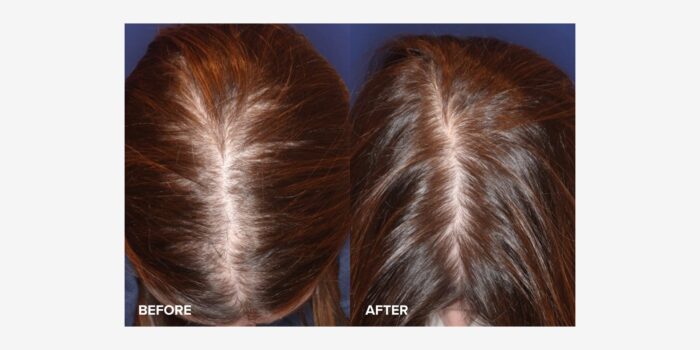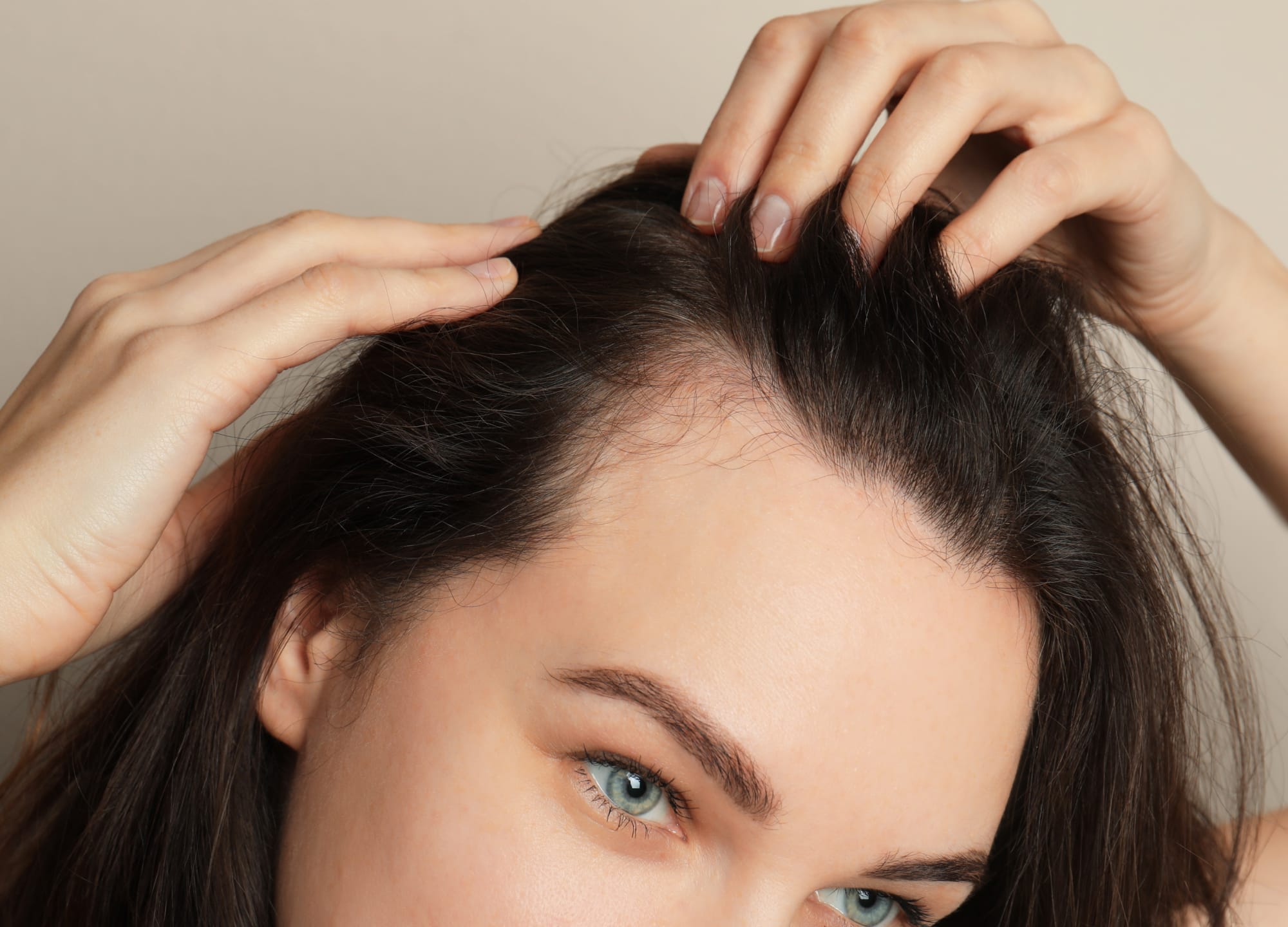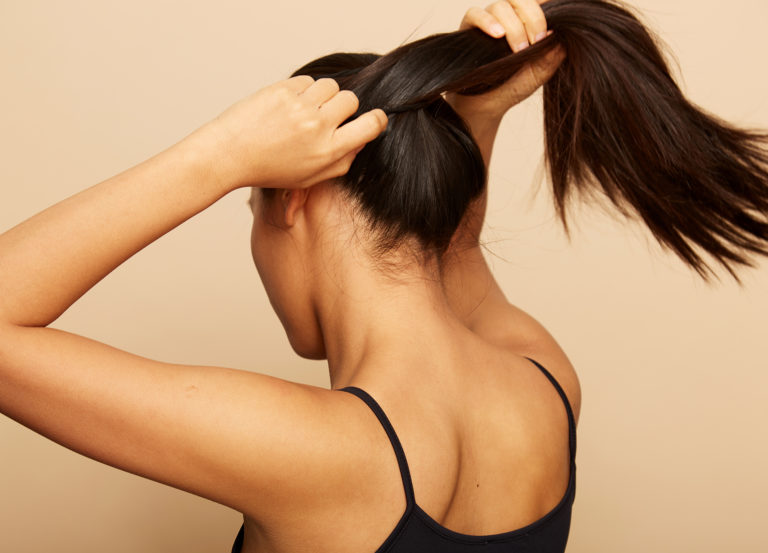Much to my chagrin, I’ve never been the person with luxuriously thick hair. I’ve always envied people who need only to wrap their ponytail twice with a hair elastic to keep it secure—I’m typically a three or four times kind of gal. And as I’ve gotten older, I’ve observed my ponytail shrinking even more—and worse, my lifelong center part getting wider and wider, with more scalp peeking through than I care to admit.
I’ve tried multiple hair-loss topicals over the years, but so many of the formulas out there to treat it require twice-daily use and feature a sticky texture that is not remotely conducive to next-day wear. Considering I have color-treated hair, daily washing is a no-go for me. So when I started learning about exosome therapy—and how effective it could be for treating hair loss—my curiosity was immediately piqued.
What is exosome therapy for hair loss?
Treatment with exosomes is relatively new but growing rapidly in hype, thanks to professional procedures like Exo-Xom. I like to tell people it’s like PRP on steroids. “Exosomes are responsible for cell-to-cell communication and for facilitating the exchange of RNA and other important proteins in cells,” explains Dr. Jennifer Levine, a board-certified facial plastic surgeon in New York City. “Additionally, they transfer numerous growth factors and cytokines, to improve tissue repair and skin cells.”
What’s special about exosomes is that they’re not cells but vesicles (little bubbles, basically) released by cells. Because they aren’t cells, you don’t have to go through the time-consuming process of extracting your blood, separating it using a centrifuge, and having the plasma or any other materials applied to your skin—and there’s no risk of a negative reaction from working with a manufactured product. Exosomes are readily available to providers and can be used pretty safely as a topical treatment.
When it comes to addressing hair loss, Dr. Levine explains that the exosomes help push the follicles into the anagen (or growth) phase while helping the surrounding tissue promote more effective growth. This makes sense, as a 2021 study shows that exosomes stimulate angiogenesis, or blood vessel formation, as well as reduce inflammation—and reduced blood flow and increased inflammation are enemies of healthy hair.
When being treated with exosomes, you’ll get the best results by pairing them with a treatment that causes intentional micro injuries to the skin, such as a laser treatment or collagen induction therapy. For my own hair-loss treatments, Dr. Levine recommended the use of traditional microneedling. “The microneedling creates channels, to help the exosomes penetrate deeper and more effectively,” she says. She adds that it’s not for everyone: “This treatment is best on patients with mild to moderate hair loss—it would not be recommended for someone who is completely bald,” she says. “[However,] it is helpful for most people.”
What does exosome therapy for hair loss feel like?
If you’ve ever gotten professional microneedling before, you know that the needles go deeper into the skin than those of an at-home dermaroller ever could. That said, the microneedling tool doesn’t need to penetrate the skin incredibly deeply for this treatment—and as you might imagine, there’s not a lot of tissue to work with here. The area is pretty bony as is. We didn’t use numbing cream, but for the most part, the microneedling didn’t cause much discomfort.
Every week for six weeks, I dutifully visited Dr. Levine’s medical aesthetician, Christian Kelly, to have my scalp professionally poked at. She worked carefully and methodically, stamping my scalp with the microneedling tool in sections, from the front of my hairline to the back of my crown. Once she got halfway through my scalp, she would crack open a small vial filled with a fluid containing exosomes from the manufacturer Benev, then rub the formula into my scalp with her fingertips. This provided a very soothing sensation—because exosomes must be kept cold to keep them active, the product was cooling and offered a nice sense of relief from any irritation caused by the microneedling. She would then repeat this process on the other side of my head, using up the vial in its entirety.
Once treatment was complete, my hair would look wet and slightly sticky on the top of my head, which I would conceal with either a ponytail or a baseball cap for the walk back to my apartment. A few hours later though, my hair would dry pretty smooth, with a mildly crunchy feel that was easily brushed out, leaving no residue. My only aftercare instructions were to avoid washing my hair for at least 24 hours post-treatment (which was not a challenge) and to try to use a milder shampoo when doing so.
Occasionally, I’d feel some tenderness after my appointment; it always subsided by the next morning. I’d also occasionally experience some itching in the days after my treatment, which is a normal part of the body’s healing response. This is all to say that there was nothing painful, annoying, uncomfortable, or particularly inconvenient about the treatment—and it was certainly easier than having to religiously apply at-home formulas to my scalp on a daily basis for what would likely be the rest of my life.
My exosome therapy for hair loss results

Quite honestly, I was and continue to be absolutely blown away by the results of my six-week hair-loss treatment. In fact, I was able to see a difference after one week—but considering that almost nothing works that quickly, I chalked it up to a placebo effect. Turns out, it was the real deal. (And because men tend to respond better to this treatment, some may find that once is enough.) Says Dr. Levine of the results of these treatments, “patients will notice less hair falling out. They will notice more hair growth, and the hair that grows will be thicker and healthier.”
That has certainly been the case for me. I tended to experience a surge in seasonal shedding—something about the switch in weather just seems to cause more hair fall—and after I completed my course of treatment, that shedding stopped in a dramatic way. And, of course, you can see the improved growth. My hair feels thicker at my part, and my scalp is significantly less noticeable there than it was.
I’d recently written about exosomes, so I knew that the technology has incredible potential and the providers who use it have seen remarkable results—and it was thrilling to be able to experience them for myself. Even better, this is only the beginning: Dr. Levine noted that it would take up to six months for me to see the full outcome of being treated with exosomes. How long the results will last varies from patient to patient, as everyone’s root cause of hair loss is different. To maintain what you’re seeing from exosome treatments for hair loss, Dr. Levine recommends regular maintenance.
Of course, I’m sure you’re wondering about the price. Currently, Dr. Levine charges $1,000 per treatment at her practice; a treatment series gets more budget-friendly, thanks to package pricing. These prices are pretty comparable to PRP, and many providers say that it’s far more effective. For some, the investment may be hard to swallow, but for many, the benefits in increased confidence courtesy of thicker hair will outweigh the cost, and I include myself in that group. I mean, considering that a fancy cocktail in New York can ring in at $20, I’d certainly be willing to sacrifice several months of happy hour in favor of fuller hair.











